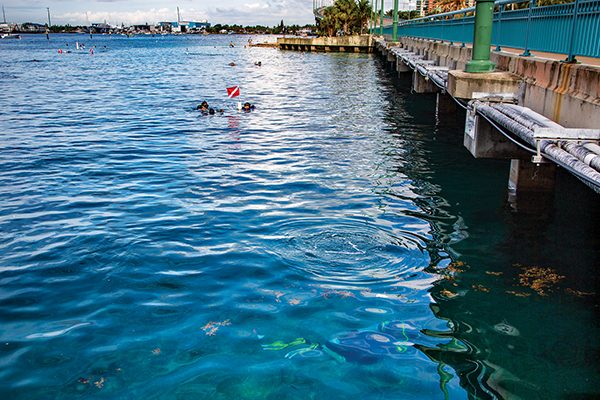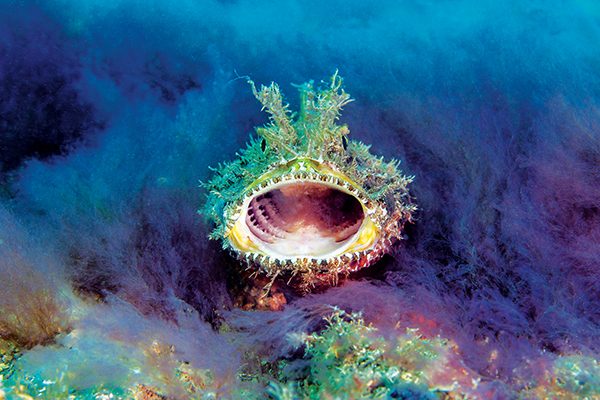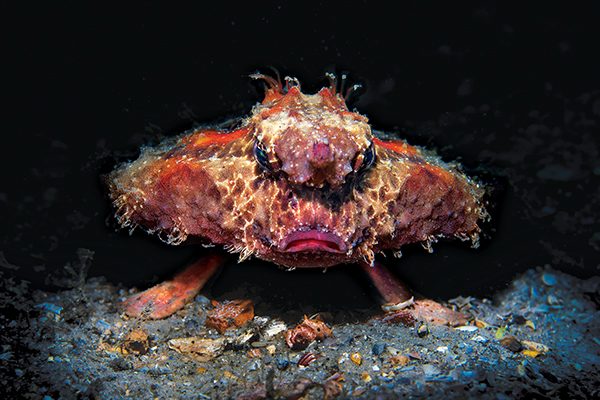Unexpected and full of surprises
THE RELENTLESS AND POWERFUL NORTHWARD FLOW of the Gulf Stream’s clear, tropical waters provides Southeast Florida with beautiful and unique diving opportunities. Passing off the coast of Palm Beach County, the warmer, constantly flowing water nourishes and replenishes reefs and corals that support and attract an incredible diversity of marine life. The reefs offshore are easily accessible and often delight divers with beautiful blue water and visibility that can reach 100 feet.
Just inside Palm Beach Inlet lies an unexpected but wondrously pleasant surprise — the Blue Heron Bridge at Phil Foster Park. The Gulf Stream waters come in twice daily with the high tides, flowing through the inlet to the Intracoastal Waterway, transporting exotic and biodiverse marine life to settle in the shallow waters at Blue Heron Bridge. Recognized as one of the best shore and muck diving sites in the U.S., it’s also considered some of the best muck diving among divers and underwater photographers worldwide.
Don’t expect colorful reefs; prepare instead for a menagerie of unusual and exotic sea life you would typically have to travel the world to see. Every dive can be a surprise — you never know what’s lurking in the next high tide.
Phil Foster Park — better known as Blue Heron Bridge, the Bridge, or just BHB — is a small island inside the Lake Worth Lagoon just off the Intracoastal Waterway. It’s connected to the mainland by two bridges leading from Riviera Beach to Singer Island. There is convenient parking just off the beach, allowing divers to gear up on their tailgates and walk directly from the beach into the water. Divers share the park with beachgoers, who can fill the beach on nice days, so we arrive a couple of hours before high tide. A great dive community frequents BHB, so arriving early gives us time to socialize with fellow divers.

Divers on the east side of the Blue Heron bridge enjoy their dive at high tide in the brilliant blue water.
Diving BHB is pleasantly straightforward and has something for just about everyone. Snorkelers, novice divers, freedivers, and experienced divers will appreciate the easy entry right off the beach and the shallow waters, which average around 15 feet with a maximum depth of 25 feet. It is a macro photographer’s dream, with an abundance and variety of underwater subjects.
The BHB area is a no-take zone for tropical fish collecting. Effective April 1, 2019, the Florida Fish and Wildlife Conservation Commission (FWC) approved a regulation to “prohibit the collection and possession of marine life fishery species (species collected for and managed for the tropical aquarium trade) within the park and surrounding waters.” For many years the local dive community unwaveringly championed the cause, working with the Palm Beach County Commission and FWC to successfully implement the policy change to protect this unique area for generations to come.

in the algae, creating an eerie scene.

lips and a face only a mother can love.


The illumination on this bobbit worm in full display highlights its rainbowlike colorations.
A female Caribbean reef octopus with a watchful eye carefully clutches and aerates her eggs. Look closely to see the baby octopuses inside the egg pods.
In 2012 the city of Riviera Beach added an 800-foot snorkel trail between the beach and boat channel, creating an artificial reef parallel to the beach and 200 feet offshore. Upgrades over the years included the addition of 15 5,000-pound modules designed to look like natural reefs, three 1,500-pound cement hammerhead shark statues, and some unplanned small boat wrecks. The artificial reef acts as a nursery for countless juvenile fish species and is home to small schools of grunts, yellow jacks, and spadefish. Eels, blennies, and gobies nestle in the structures. A detailed map posted on the beach provides a helpful layout of the dive area and snorkel trail.
Diving BHB revolves around slack high tide, which offers the calmest currents and best visibility. With the shallow depths, divers can expect a dive of up to two hours or more, depending on air consumption. If you enter the water an hour before high tide, you’ll miss the currents picking up and visibility dropping significantly about an hour past high tide. The dive is generally leisurely, but tidal currents can be strong outside the two-hour dive window, especially at the bridges. Visibility during slack high tide typically ranges from 20 to 40 feet but can be as low as a couple of feet or as high as 80 feet or more, depending on the conditions.
Our dive plan usually starts just off the beach outside the swim area, where we explore the sandy, grassy shallows and allow the tidal currents to diminish before we approach one of the bridges. At first it may appear to be just an uninteresting, sandy, shallow dive, but surprises reward the patient and observant diver.

Seaweed blennies display their personalities as they peep out through their dens playing hide-and-seek.
The shallows are home to seahorses, frogfishes, and octopuses, many in 4 to 5 feet of water scarcely off the beach. Flying gurnards and sea robins walk the bottom, and a school of large rainbow parrotfish frequents the area and feeds on the incoming tide. Garden eels play their jack-in-the-box game as you approach and recede, and buffalo trunkfish and filefish are common in the grasses.
Frogfish in many colors, shapes, and sizes arrive in late winter or early spring. BHB is home to striated, ocellated, and dwarf frogfish, and seeing a half dozen in a single dive is not unusual. Patient and skilled divers might discover dwarf frogfish well-camouflaged in the seabed. A sargassum frogfish is a rare treat that requires frequent checks and careful examination of the incoming sargassum floating on the surface. Some fortunate divers have witnessed the spawning ritual of frogfish when the female releases her eggs into the water column and males eagerly swim through the cloud to fertilize the eggs.
Lined and longsnout seahorses in various textures, colors, and patterns visit, but they are challenging to find at times — the frillier ones and juveniles blend perfectly with their grassy surroundings. Others hide in sponges matching their coloration. On a few occasions we’ve seen a bright red one standing out like a sore thumb, brazenly swimming through the sandy, grassy areas, tail clinging to seagrass as it slowly hunts for food, seemingly without a care in the world. They are often in mated pairs, and some divers have been fortunate to witness females passing their eggs to the male’s specialized brooding pouch or the male hatching babies into the water.
Octopuses become scarce over the winter, but in early spring Atlantic longarm, Caribbean reef, brown-striped, and common octopuses start to return in numbers. Octopuses seem to adjust to divers and are often out and about in the sand during the day. Sometimes they are playful, and it seems as if they are posing for the camera with some of their antics — changing colors and textures, grabbing shells to decorate their dens, and pouring like liquid into crevices and holes. Bottles and cans are favorite spots for them to make homes.
Every dive can be a surprise —
you never know what’s lurking in the next high tide.
More than 100 species of nudibranchs and sea slugs are at BHB, but most are tiny, unlike those in the Indo-Pacific. Divers with extreme patience, a keen eye, and knowledge of the habitat enjoy the search and successfully find these small creatures. Admittedly, we have yet to develop that skill, or maybe we don’t have the sharp eyesight required, so we rely on the assistance of more advanced nudibranch finders. Photographing them requires strong diopters. On the larger side, Florida regal sea goddesses occasionally find their way from offshore wrecks to BHB. We had a pleasant surprise this past fall with the arrival of a few Janolus flavoanulatus, which aren’t invasive, but they don’t belong here and typically live in the Western Indo-Pacific. Speculation is that they hitched a ride on a cargo ship. They disappeared a few weeks later, almost as abruptly as they arrived.
After spending time in the shallows off the beach, we head off to explore one of the bridges shortly before high tide. Covering the east- and west-side bridges in a single dive is too much. It’s more fun exploring a smaller area, so we pick one and save the other for another day. It’s incredible what you can find using a slow and steady approach. Urchins and starfish pepper the sandy, shelly areas leading to the east bridge, which are excellent places to stop and look for tiny sea life such as bumble bee shrimp. Decorator urchins pile on an amusing amount of junk to camouflage themselves. There are a few unusual critters such as tiger mantis shrimp, decorator crabs, bobbit worms, pipefish, and three species of batfish (polka-dot, shortnose, and roughback). Scorpionfish and stargazers lie entirely camouflaged on the bottom, stealthily awaiting their prey. Yellowhead and banded jawfish can be found in their burrows, sometimes with the male mouthbrooding eggs. Caribbean reef squid and grass squid are occasionally in the water column. Under the east bridge is home to lobsters, green and spotted moray eels, cardinalfish, and seahorses.
A male bluethroat pikeblenny shows off his throat and dorsal fin to impress and attract the nearby females.

A female Caribbean reef octopus selected the east bridge to raise her eggs early this year, making her final home in an 8-inch abandoned pipe about 3 feet off the sand. Seeking safety and privacy, she attached her clutch of eggs to the pipe’s walls about a foot back from the opening, her arms in constant motion aerating and cleaning the eggs. After the first sighting early in March, she stayed in her den for the next six weeks until her eggs hatched. She was gone about a week after the eggs hatched. It was extraordinary and humbling to check on her and watch the babies’ development. The cycle of life continues, and it was wonderful to share in it.
The west bridge crosses the main boat channel and is much higher to allow large boats to pass. The dive area is home to much of the same marine life as the east side. Large gray, French, and queen angelfish and schools of spadefish swim under the span. Colorful sponges cover the large pilings that support the bridge and are habitats for arrow crabs, banded coral shrimp, and blennies. A sandy knoll covered in seagrass just south of the span is home to headshield slugs, colorful hermit crabs, and bluethroat pikeblennies. Both bridges are fun to dive, with many similarities in marine life, but the action can change over time from one to the other.
We generally shoot macro at BHB, but larger marine life occasionally passes through. It can be a real surprise when your face is close to the bottom as you search for tiny critters and then are face-to-face with a goliath grouper when you look up. While they are docile, seeing a fish the size of a small car under the bridge can still give you quite a start. Spotted eagle rays are relatively common, hunting with the tides in groups of two to four. Manatees sometimes look for warmer water in the winter months, nurse sharks are not uncommon, and divers may occasionally see a turtle.
Night dives at BHB are also an excellent opportunity to find sea life that generally hides during the day. The park closes at sunset, but local dive shops host night dives twice monthly. You need a special pass, available free from the local dive shop hosting the night dive.
We’ve been residents of Palm Beach County since 2020 and retired here in part because of the variety of dive opportunities. We love Blue Heron Bridge and dive here as often as possible when the conditions are good and the tides cooperate. We dive year-round with water temperatures ranging from 72°F to 86°F. Its variety, never-ending surprises of exotic marine life, fantastic dive community, incredible photographic opportunities, and ease of access make it a dive site that’s hard to beat anywhere in the world. AD
EXPLORE MORE
Discover more of what Blue Heron Bridge offers in a bonus photo gallery and these videos.




























https://youtube.com/watch?v=ConH2nL5WdA%3Ffeature%3Doembedhttps%3A
© Alert Diver — Q3 2022